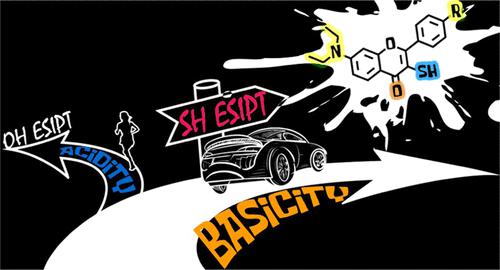当前位置:
X-MOL 学术
›
J. Am. Chem. Soc.
›
论文详情
Our official English website, www.x-mol.net, welcomes your
feedback! (Note: you will need to create a separate account there.)
Hydrogen-Bonded Thiol Undergoes Unconventional Excited-State Intramolecular Proton-Transfer Reactions
Journal of the American Chemical Society ( IF 14.4 ) Pub Date : 2024-01-30 , DOI: 10.1021/jacs.3c10405
Jian-Kai Wang, Chih-Hsing Wang, Chi-Chi Wu, Kai-Hsin Chang, Chun-Hsiang Wang, Yi-Hung Liu, Chao-Tsen Chen, Pi-Tai Chou
Journal of the American Chemical Society ( IF 14.4 ) Pub Date : 2024-01-30 , DOI: 10.1021/jacs.3c10405
Jian-Kai Wang, Chih-Hsing Wang, Chi-Chi Wu, Kai-Hsin Chang, Chun-Hsiang Wang, Yi-Hung Liu, Chao-Tsen Chen, Pi-Tai Chou

|
The chapter on the thiol-related hydrogen bond (H-bond) and its excited-state intramolecular proton-transfer (ESIPT) reaction was recently opened where compound 4′-diethylamino-3-mercaptoflavone (3NTF) undergoes ESIPT in both cyclohexane solution and solid, giving a 710 nm tautomer emission with an anomalously large Stokes shift of 12,230 cm–1. Considering the thiol H-bond to be unconventional compared to the conventional Pauling-type –OH or –NH H-bond, it is thus essential and timely to probe its fundamental difference between their ESIPT. However, thiol-associated ESIPT tends to be nonemissive due to the dominant nπ* character of the tautomeric lowest excited state. Herein, based on the 3-mercaptoflavone scaffold and π-elongation concept, a new series of 4′-substituted-7-diethylamino-3-mercaptoflavones, NTFs, was designed and synthesized with varied H-bond strength and 690–720 nm tautomeric emission upon ultraviolet (UV) excitation in cyclohexane. The order of their H-bonding strength was experimentally determined to be N-NTF < O-NTF < H-NTF < F-NTF, while the rate of –SH ESIPT measured by fluorescence upconversion was F-NTF (398 fs)−1 < H-NTF (232 fs)−1 < O-NTF (123 fs)−1 < N-NTF (101 fs)−1 in toluene. Unexpectedly, the strongest H-bonded F-NTF gives the slowest ESIPT, which does not conform to the traditional ESIPT model. The results are rationalized by the trend of carbonyl oxygen basicity rather than –SH acidity. Namely, the thiol acidity relevant to the H-bond strength plays a minor role in the driving force of ESIPT. Instead, the proton-accepting strength governs ESIPT. That is to say, the noncanonical thiol H-bonding system undergoes an unconventional type of ESIPT.
中文翻译:

氢键硫醇经历非常规激发态分子内质子转移反应
最近开设了有关硫醇相关氢键(H-bond)及其激发态分子内质子转移(ESIPT)反应的章节,其中化合物4'-二乙氨基-3-巯基黄酮( 3NTF )在环己烷溶液和固体,产生 710 nm 互变异构体发射,斯托克斯位移异常大,为 12,230 cm –1 。考虑到硫醇氢键与传统的鲍林型-OH或-NH氢键相比是非常规的,因此有必要及时探讨其与ESIPT之间的根本区别。然而,由于互变异构最低激发态的主导n π* 特征,硫醇相关的 ESIPT 往往是非发射性的。在此,基于3-巯基黄酮支架和π-延伸概念,设计并合成了一系列具有不同氢键强度和690-720 nm互变异构体的新系列4′-取代-7-二乙氨基-3-巯基黄酮NTF 。在环己烷中紫外 (UV) 激发时的发射。实验确定它们的氢键强度顺序为N-NTF < O-NTF < H-NTF < F-NTF ,而通过荧光上转换测量的 -SH ESIPT 速率为F-NTF (398 fs) −1 < H-NTF (232 fs) -1 < O-NTF (123 fs) -1 < N-NTF (101 fs) -1在甲苯中。出乎意料的是,最强的氢键F-NTF给出了最慢的ESIPT,这不符合传统的ESIPT模型。结果通过羰基氧碱性而不是-SH酸性的趋势合理化。也就是说,与氢键强度相关的硫醇酸性在 ESIPT 的驱动力中起着次要作用。 相反,质子接受强度控制 ESIPT。也就是说,非常规硫醇氢键系统经历了非常规类型的 ESIPT。
更新日期:2024-01-30
中文翻译:

氢键硫醇经历非常规激发态分子内质子转移反应
最近开设了有关硫醇相关氢键(H-bond)及其激发态分子内质子转移(ESIPT)反应的章节,其中化合物4'-二乙氨基-3-巯基黄酮( 3NTF )在环己烷溶液和固体,产生 710 nm 互变异构体发射,斯托克斯位移异常大,为 12,230 cm –1 。考虑到硫醇氢键与传统的鲍林型-OH或-NH氢键相比是非常规的,因此有必要及时探讨其与ESIPT之间的根本区别。然而,由于互变异构最低激发态的主导n π* 特征,硫醇相关的 ESIPT 往往是非发射性的。在此,基于3-巯基黄酮支架和π-延伸概念,设计并合成了一系列具有不同氢键强度和690-720 nm互变异构体的新系列4′-取代-7-二乙氨基-3-巯基黄酮NTF 。在环己烷中紫外 (UV) 激发时的发射。实验确定它们的氢键强度顺序为N-NTF < O-NTF < H-NTF < F-NTF ,而通过荧光上转换测量的 -SH ESIPT 速率为F-NTF (398 fs) −1 < H-NTF (232 fs) -1 < O-NTF (123 fs) -1 < N-NTF (101 fs) -1在甲苯中。出乎意料的是,最强的氢键F-NTF给出了最慢的ESIPT,这不符合传统的ESIPT模型。结果通过羰基氧碱性而不是-SH酸性的趋势合理化。也就是说,与氢键强度相关的硫醇酸性在 ESIPT 的驱动力中起着次要作用。 相反,质子接受强度控制 ESIPT。也就是说,非常规硫醇氢键系统经历了非常规类型的 ESIPT。

































 京公网安备 11010802027423号
京公网安备 11010802027423号